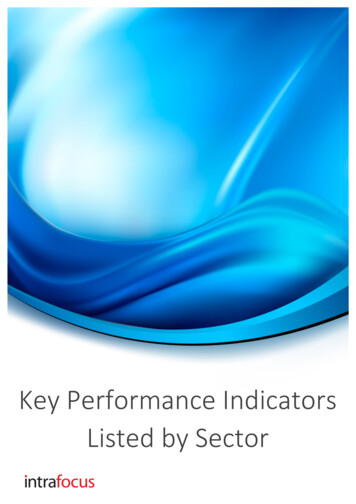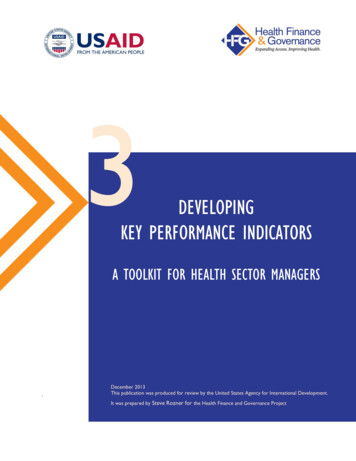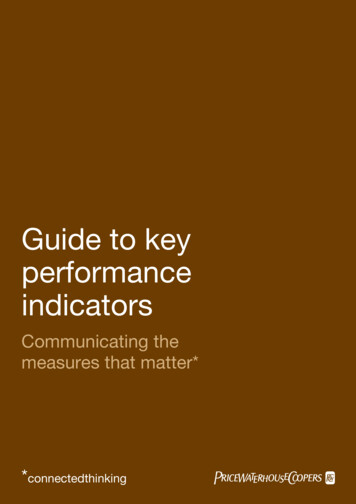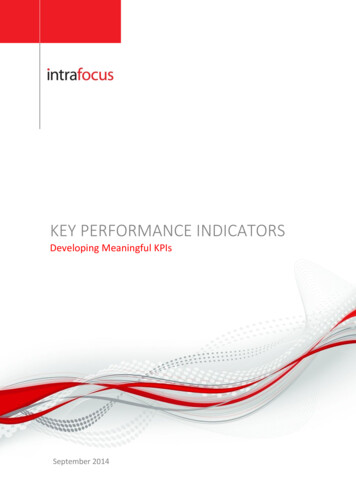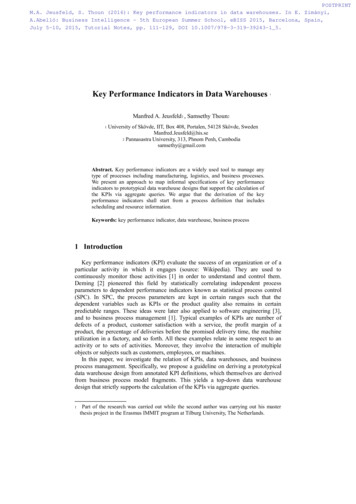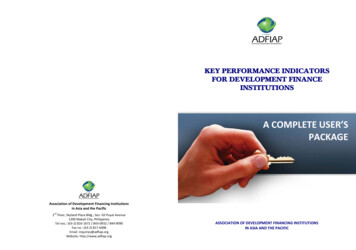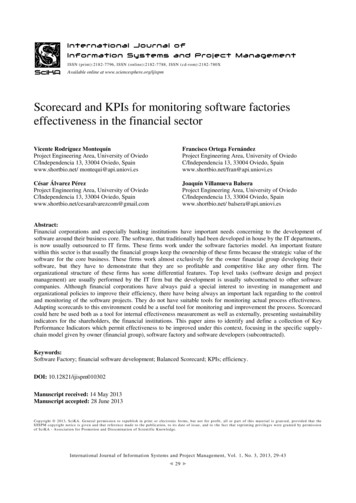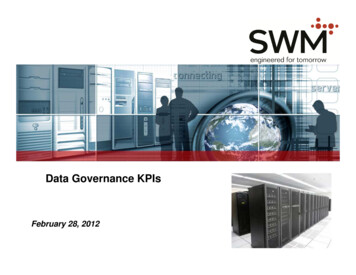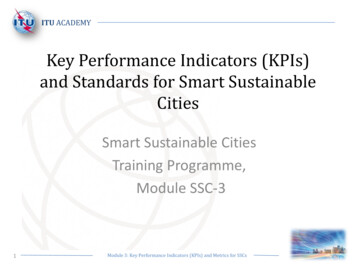
Transcription
ITU ACADEMYKey Performance Indicators (KPIs)and Standards for Smart SustainableCitiesSmart Sustainable CitiesTraining Programme,Module SSC-31Module 3: Key Performance Indicators (KPIs) and Metrics for SSCs
ITU ACADEMYContentsAim of this ModuleOverview of KPIs for SSCsKPI definitions for SSCsKPI level and usage of ICT for SSCsMetrics and evaluation of KPIs for SSCsKPIs related to the sustainability impacts of ICT inSSCs Review of standardization activities and gaps forSSC 2Module 3: Key Performance Indicators (KPIs) and Metrics for SSCs
ITU ACADEMYAims of this Module To provide an overview of KPIs To enable you to understand the scope andpriorities for SSCs To enable you to understand how ICTperformance can be measured in its own sector To enable you to understand the impact of ICT onthe KPIs of other sectors To show how emerging standards can allowcomparisons to be made between one year andanother or one city and another3Module 3: Key Performance Indicators (KPIs) and Metrics for SSCs
ITU ACADEMYKPI Overview4Module 3: Key Performance Indicators (KPIs) and Metrics for SSCs
ITU ACADEMYHow do KPIs work? Key performance indicators define sets ofvalues against which to measure These raw sets of values, which are fed tosystems in charge of summarizing theinformation, are called indicators Indicators are identifiable and marked aspossible candidates for KPIs– They can be summarized into sub-categoriesSource: http://en.wikipedia.org/wiki/Performance indicator5Module 3: Key Performance Indicators (KPIs) and Metrics for SSCs
ITU ACADEMYBenefits of SSC KPI Development For city dwellers and non-profit citizen organizations– by enabling them to understand the development and progress of SSCwith respect to ICT's impact. For the development and operation of SSC organizations,including planning units, service providers, operation andmaintenance organizations, among others– by helping them to fulfil the tasks of sharing information related to theuse of ICTs and their impact on the sustainability of cities. For evaluation and ranking agencies, including academia– by supporting them in the selection of relevant KPIs for assessing thecontribution from ICT in the development of SSC.Source: FG-SSC Key performance indicators definitions for smartsustainable cities, page 76Module 3: Key Performance Indicators (KPIs) and Metrics for SSCs
ITU ACADEMYOverview of KPIs #1 The proposed set of KPIsfocuses specifically on a set ofICT related indicators for smartsustainable cities but does notcover all KPIs of citiescontained in the ISO standard37120 [ISO 37120]. The dimensions of KPIs can becategorized as– Information and CommunicationTechnology– Environmental sustainability– Productivity– Quality of life– Equity and social inclusion– Physical infrastructure7Source: FG-SSC “OverviewModuleof keyperformance indicators in smart sustainable3: Key Performance Indicators (KPIs) and Metrics for SSCscities”, Page 3
ITU ACADEMYOverview of KPIs #2 Each dimension is subdividedinto further KPIs One example is illustrated for‘ICTs’ (D1)ICTD1.1 Network and accessD1.2 Services and information platformsD1.3 Information security and privacyD1.4 Electromagnetic field8Source: FG-SSC “Overview of key performance indicators in smart sustainableModule 3: Key Performance Indicators (KPIs) and Metrics for SSCscities”, Page 4
ITU ACADEMYOverview of KPIs #3 The other 5 dimensionsare not specifically in theICT sector but canbenefit from the use ofICT to improve their ownperformance asmeasured by KPIsSource: FG-SSC “Overview of key performance indicators in smart sustainableModule 3: Key Performance Indicators (KPIs) and Metrics for SSCs9cities”,Pages 6-9
ITU ACADEMYNext:KPI Definitions for SSCs10Module 3: Key Performance Indicators (KPIs) and Metrics for SSCs
ITU ACADEMY Selection of KPIsis based on the following principles– Comprehensiveness: The set of indicators should cover all the aspects of SSC and bealigned to “ICT and its impact on the sustainability of cities” The indices should reflect the level of general development in a certain aspect– Comparability: The KPIs should be defined in a way that data can be comparedscientifically between different cities according to different phases of urbandevelopment, which means the KPIs must be comparable over time and space.– Availability: The KPIs should be quantitative and the historic and current data should beeither available or easy to collect.– Independence: The KPIs in the same dimension should be independent or almostorthogonal i.e., overlap of the KPIs should be avoided as much as possible.– Simplicity: The concept of each indicator should be simple and easy to understand the calculation of the associated data should be intuitive and simple– Timeliness: The ability to produce KPIs with respect to emerging issues in SSCconstruction or stage or developmentSource FG-SSC “Key performance indicators related to the use of informationand communication technology in smart sustainable cities ”, Page 411Module 3: Key Performance Indicators (KPIs) and Metrics for SSCs
ITU ACADEMYHow are KPIs chosen? The FG-SSC made a comparative analysis of nineteen differentindex sets regarding KPIs and evaluation index systems ofsmart cities and sustainable cities, etc. * The ‘core indicators’ are chosen as applicable to all cities** ‘Additional-indicators ‘– Reflect the degree of smartness and sustainability which differs between cities– Thus, based on their stage of economic development or/and population growth etc., thecities can also select appropriate indicators among those listed in Appendix I and/or usenew ones.Source: *FG-SSC “Key performance indicators definitions for smart sustainable cities”,Page 8 and“Key performance indicators related to the sustainability impacts of information andcommunication technology in smart sustainable cities”, page 212Module 3: Key Performance Indicators (KPIs) and Metrics for SSCs
ITU ACADEMYSub Dimensions of KPIs #1 Each Dimension can be broken down into Sub-Dimensions For example a KPI for ICT can be broken down into– Network and access– Services and information platforms– Information security and privacy– Electromagnetic field (Each sub dimension may be given a score and weightingwhich contributes to the overall KPI)Source: FG-SSC “Overview of key performance indicators in smartsustainable cities” Page 413Module 3: Key Performance Indicators (KPIs) and Metrics for SSCs
ITU ACADEMYSub Dimensions of KPIs #2 Network and access refers to the network layer in the Open SystemsInterconnection (OSI) model, especially backboneand access networks, including optical broadband,wireless broadband and broadcasting network. Services and information platforms refers to ICT services and equipment above thenetwork layer, including software services andprivate handsets.Source: FG-SSC “Overview of key performance indicators in smartsustainable cities”, Page 414Module 3: Key Performance Indicators (KPIs) and Metrics for SSCs
ITU ACADEMYSub Dimensions of KPIs #3 Information security and privacy refers to the security parts including privacyprotection. Electromagnetic field Application of exposure guidelines, consistentplanning approval process and information forpublic should be considered with respect toElectromagnetic fields.Source: FG-SSC “Overview of key performance indicators in smartsustainable cities”, Page 415Module 3: Key Performance Indicators (KPIs) and Metrics for SSCs
ITU ACADEMYOther Sub-Dimensions #1 Environmental sustainability Air quality, CO2 emissions, Energy, Indoor pollution,water , soil and noise Productivity Capital investment, Employment, Inflation, Trade,Savings, Export/import, Householdincome/consumption, Innovation, Knowledgeeconomy Quality of life Education, Health, Safety/security public place,Convenience and comfortSource: FG-SSC “Overview of key performance indicators in smartsustainable cities”, Page 516Module 3: Key Performance Indicators (KPIs) and Metrics for SSCs
ITU ACADEMYOther Sub-Dimensions #2 Equity and social inclusion Inequity of income/consumption (Gini coefficient) (A Gini coefficient of zero expresses perfect equality, where all valuesare the same (for example, where everyone has the same income)). Social and gender inequity of access to services andinfrastructure Openness and public participation Governance Physical infrastructure piped water, sewage systems, electricity, waste management,knowledge infrastructure, health infrastructure, transport,roads, buildingsSource: Source: FG-SSC “Overview of key performance indicators in smart sustainable cities”,Page 5&617Module 3: Key Performance Indicators (KPIs) and Metrics for SSCs
ITU ACADEMYAre Indicators Quantifiable? Example It is desirable that each city can quantify continuouslyan achievement degree according to their goalfollowing KPIs* Indicators need to have a numerical value– Normally a high number is good and a low number is bad The KPIs should be quantitative and the historic andcurrent data should be either available or easy tocollect**. One example is an indicator for the sub-dimension“Network Facilities” The indicator is “Fixed (wired)-broadbandsubscriptions per 100 inhabitants”– This is qualified by being at a download rate of at least256kbit/s– It is“Overviewfurtherofqualifiedby excludingmobilesubscriptionsSource: *FG-SSCkey performanceindicators insmart sustainablecities”18Page 1; **”Key performance indicators related to the sustainability impacts of information and communication technology in smartsustainable cities”, page 5; and ***”Key performance indicators related to the use of information and communication technology insmart sustainable cities”, page 6Module 3: Key Performance Indicators (KPIs) and Metrics for SSCs
ITU ACADEMY‘Independency’ is a SelectionPrinciple for KPIs Mobile Networks are identifiedindependently from fixed networkswith the smallest possible overlap The indicator for Mobile Networksis defined as– “Wireless-broadband subscriptionsper 100 inhabitants” It includes– satellite, terrestrial fixed wirelessand mobile wireless subscriptionsSource FG-SSC “Key performance indicators related to the use of informationand communication technology in smart sustainable cities”, pages 6&719Module 3: Key Performance Indicators (KPIs) and Metrics for SSCs
ITU ACADEMYHow many Indicators are needed? So far over 100 have been proposed byFG-SSC– Some will be qualitative rather thanmeasurable quantities as in the previoustwo examples– They will be given subjective scores such as 10 high 1 low Not all human needs can be quantified!Source FG-SSC “Key performance indicators related to the use ofinformation and communication technology in smart sustainable cities”20Module 3: Key Performance Indicators (KPIs) and Metrics for SSCs
Example: Smart City Indicators #1ITU ACADEMY The emerging and sustainable cities initiative (ESCI)– was created by the Inter-American Development Bank (IDB) in 2010– in response to rapid and largely unregulated urbanization in the LatinAmerican and Caribbean region,– It addresses three dimensions of sustainability: environmental sustainability and climate change, urban sustainability fiscal sustainability and governance21Source: le-cities-initiative-approach,7641.htmlITU-T Focus Group on Smart Sustainable Cities: Key performance indicators definitions for smartModule 3: Key Performance Indicators (KPIs) and Metrics for SSCssustainable cities Annex K
Example: Smart City Indicators #2ITU ACADEMYESCI lists 107IndicatorsICT appear in69-7122Source: le-cities-initiative-approach,7641.htmlITU-T Focus Group on Smart Sustainable Cities: Key performance indicators definitions for smartModule 3: Key Performance Indicators (KPIs) and Metrics for SSCssustainable cities Annex K
Example: Smart City Indicators #3ITU ACADEMYCoverage:GSMA predicts thatmore than 80%people worldwide willhave access to 3Gnetworks by 2020 (upfrom 70%today/2015), while4G networks willcover over 60% ofthe global population(up from 25% today).Sources: oadband23reach-expanding-globally/453/Module 3: Key Performance Indicators (KPIs) and Metrics for SSCs
Weighting factors: ExampleITU ACADEMY An example from International Data Corporation (IDC)CriteriaSmart governmentSmart buildingsSmart mobilitySmart energy and environmentSmart servicesTotalweighting2020202020100 In this case the indicators in each dimension are scaledto reach a score of 20– Each dimension can have a different weighting*24Source FG-SSC “Key performance indicators definitions for smart sustainable cities”*See also page 3 ofModule 3: Key Performance Indicators (KPIs) and Metrics for SSCshttp://www.portalidc.com/resources/white papers/IDC Smart City Analysis Spain EN.pdf
ITU ACADEMYNext:KPIs related to the use of ICT inSSCs25Module 3: Key Performance Indicators (KPIs) and Metrics for SSCs
ITU ACADEMYWho may use the KPIs? City officials and municipal administrations– enabling them to develop strategiesand understand the progress related to the use of ICT for makingcities smarter and more sustainable City residents and non-profit organizations– enabling them to understand the development and progress of SSC City service providers, operation and maintenance organizations– helping them to fulfil the tasks of sharing information related to theuse of ICT in the city Evaluation and ranking agencies, including academia– supporting them in selection of relevant KPIs for assessing thecontribution from ICT in the development of SSCSource: FG-SSC “Overview of key performance indicators in smart sustainable cities” page 1,also “Key Performance Indicators (KPIs) related to the level and usage of Information andin 3:SmartSustainableCities”,page5ModuleKey PerformanceIndicators(KPIs)and Metricsfor SSCs26 Communication Technology (ICT)
ITU ACADEMYHow are KPIs Generated? Follow these steps– Data collection select suitable data sources and data collections for each indicator– Data normalization transform all the raw data into a normalized value for each indicator– Data aggregation aggregate the normalized value of each indicator for each dimension– Data assessment assess the result of all the dimensions for the final index– SSC evaluation draw the conclusion from the final index27Module 3: Key Performance Indicators (KPIs) and Metrics for SSCs
Example: Smart City DashboardITU ACADEMYProposed by Cisco for Hyderabad28Source: Prakash Kumar, Cisco,“Smart Cities, Global Experiences and Lessons for -cities-global-experiences-and-lessons-forModule 3: Key Performance Indicators (KPIs) and Metrics for SSCsindia-at-asci-hyderabad-25-apr-2013
ITU ACADEMYKPIs related to the sustainabilityimpacts of ICT in SSCs29Module 3: Key Performance Indicators (KPIs) and Metrics for SSCs
ITU ACADEMYWhat is Meant bySustainability? The sustainability of a smart city is based on four mainaspects– Economic the ability to generate income and employment for the livelihood ofthe inhabitants– Social the ability to ensure that “well-being” (safety, health, education) canbe equally delivered to all regardless of class, race or gender– Environmental the ability to protect future quality and reproducibility of naturalresources– Governance the ability to maintain social conditions of stability, participation, andjusticeSource: FG-SSC Technical Report on Key Performance Indicators (KPIs) related to the sustainabilityimpacts of Information and Communication Technology (ICT) in Smart Sustainable Cities page 630Module 3: Key Performance Indicators (KPIs) and Metrics for SSCs
ITU ACADEMYNext:Review of standardizationactivities and gaps for SSC31Module 3: Key Performance Indicators (KPIs) and Metrics for SSCs
ITU ACADEMYStandards may be classified intoFour Categories Smart City management and assessment SSC services Information and Communication Technology(ICT) Buildings and physical infrastructuresSource: Source: FG-SSC “Technical Report on Standardization Roadmap for SSC”pages 3-432Module 3: Key Performance Indicators (KPIs) and Metrics for SSCs
ITU ACADEMYChallenges In addition to ITU-T, a number of otherimportant standards bodies are working toscope out and develop Smart City and SSCstandards. Standards may not necessarily reflect thecomplexity of dealing with a SSC as a systemof systemsSource: Source: FG-SSC “Technical Report on Standardization Roadmap for SSC”,Page 633Module 3: Key Performance Indicators (KPIs) and Metrics for SSCs
ITU ACADEMYStandards Gap Analysis#1 FG-SSC– Possible topics for future Recommendations in ITU are identified in TechnicalReports*– Examples include "Overview of key performance indicators in smart sustainable cities" "An overview of smart sustainable cities and the role of information and communicationtechnologies" "Smart sustainable cities: an analysis of definitions" "Smart water management in cities" "Electromagnetic field considerations in smart sustainable cities“ 13 deliverables have been approved by the FG 10 other reports are currently at a draft stage which could be candidates for future standards or ITURecommendations. These are due to be completed in May 2015Note that Contribution 404 to the ITU-T Meeting in Kochi 8 - 19 December 2014 isentitled “Proposal to create a new Question on Smart Sustainable Cities”–It was agreed that a new Question, number 20, should be set up on this topic.*Source: FG-SSC Draft Technical Report on Standardization Activities and Gaps forSSC and suggestions to SG5 page 734Module 3: Key Performance Indicators (KPIs) and Metrics for SSCs
ITU ACADEMYStandards GapAnalysis#2Standardisation gapswere considered foreach aspect in theFigure 128 Gaps have beenidentifiedMost of these could betopics for ITU withcollaboration with otherSDOs*Source: ITU-T Focus Group onSmart Sustainable Cities:“Standardization roadmap forsmart sustainable cities” Page 735Module 3: Key Performance Indicators (KPIs) and Metrics for SSCs
ITU ACADEMYExamples of SDOs workingon standards for SSCs #1Standards Developing Organizations (SDOs) International Organization for Standardization (ISO) ISO/AWI TR 37121– Approved new Work Item (AWI)– Inventory and review of existing indicators on sustainable development andresilience in cities– Under development ISO/DIS 37120– Draft International Standard– Sustainable development and resilience of communities -Indicators for cityservices and quality of life– Under developmentFG-SSC “Technical Report on Standardization Activities for SSC” Page 10436Module 3: Key Performance Indicators (KPIs) and Metrics for SSCs
ITU ACADEMYExamples of SDOs workingon standards for SSCs #2 ISO also works on standards for many otherdimensions of a SSC which are not the subject of ITU For example ISO 16346– Energy performance of buildings – Assessment of overallenergy performance Under developmentFG-SSC “Technical Report on Standardization Activities for SSC”Page 11137Module 3: Key Performance Indicators (KPIs) and Metrics for SSCs
ITU ACADEMYExamples of SDOs workingon standards for SSCs #3 ETSI– European Telecommunications Standards Institute For example TS 102 708– Intelligent Transport Systems (ITS)– Test specifications for High Data Rate (HDR) datatransmission equipment operating in the 5.8 GHz ISM band– Under developmentFG-SSC “Technical Report on Standardization Activities for SSC”Pages 91-9238Module 3: Key Performance Indicators (KPIs) and Metrics fo
Source: *FG– -SSC “Overview of key performance indicators in smart sustainable cities”It is further qualified by excluding mobile subscriptions . Page 1; **”Key performance indicators related to the sustainability impacts of information


